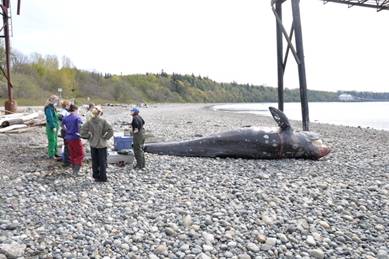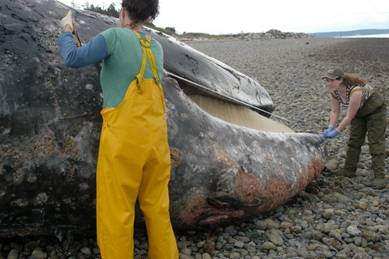Summary by John Calambokidis and Jessie Huggins, Cascadia Research in consultation with Central Puget Sound Marine Mammal Stranding Network, Whatcom Marine Mammal Stranding Network, Washington Department of Fish and Wildlife and National Marine Fisheries Service
Two gray whales were found dead in northern Puget Sound in the past week and have been examined in the last two days. While there are some similarities in the timing and some other aspects of these deaths, they do not appear otherwise related. Overall these represent the 3rd and 4th dead gray whales found this year in Washington State. This is still below the overall average number of deaths for a year and well below what occurred during some of the peak years in gray whale deaths. With close to 20,000 gray whales migrating past Washington and several dozen coming into Puget Sound, some level of mortality has been normal.
Unlike most of the past gray whales deaths, however, these animals appeared to have been in much better nutritional condition and had not starved to death. The Birch Bay whale had very high levels of fat on its body and the Camano whale had large amounts of feed in its stomach. These indicate these whales had not died of a long term debilitating condition but something more sudden. Both showed signs of traumatic injuries although we are awaiting further tests to be sure these were the ultimate cause of death. Whales are known to die from ship and boat strikes and these injuries can sometimes be hard to spot especially once decomposition has set in.
Additional details on these two whales are summarized below:
Birch Bay gray whale stranding
On 28 April, 2009, biologists from Cascadia Research, Washington Department of Fish and Wildlife, and volunteers from the Whatcom Marine Mammal Stranding Network examined a 27 foot juvenile gray whale near Birch Bay, in Whatcom County. The 1-2 year old male was found floating on 27 April and was towed by the WMMSN staff and BP Refinery to a suitable location for examination the following day.
The animal was in good body condition with a thick, oily blubber layer, unlike the emaciated young gray whales we typically find stranded during this time of year. However, despite good overall nutritional condition it did not appear to have eaten for a couple of days prior to death. There was evidence of both infection and trauma, although the source of the trauma is unknown and it is possible that the two conditions are linked. Precise cause of death could not be determined from the field examination, but many samples were collected for histopathology, genetics, contaminants and disease screening and will be analyzed in the coming weeks and months.
Camano Island gray whale stranding
On 29 April, 2009, volunteers from Central Puget Sound Marine Mammal Stranding Network met biologists from Cascadia Research and Washington Department of Fish and Wildlife to examine a large gray whale that was first seen floating off of Camano Island on 26 April, 2009. The 41 foot whale was towed on 28 April by Deception Pass Tours to a stretch of beach provided by the Whidbey Island Naval Air Station for a necropsy the next afternoon.
The adult male was moderately decomposed and in fair body condition. Significant findings from this examination included a large amount of blood in the body cavity, bruising in some areas of the blubber layer and in some internal organs, and a stomach full of recently ingested prey. These findings are suggestive of blunt force trauma, likely caused by a collision with a large ship.

